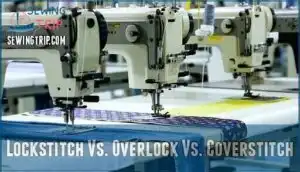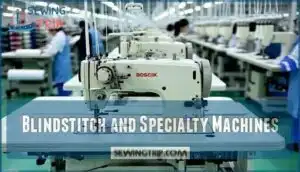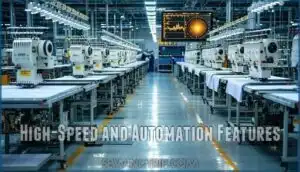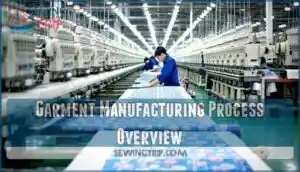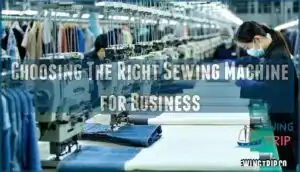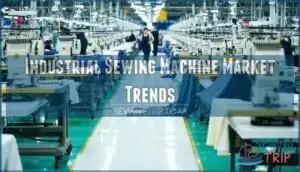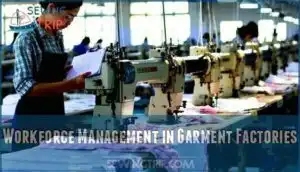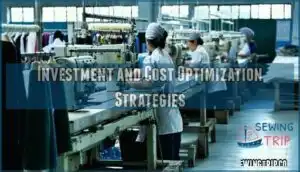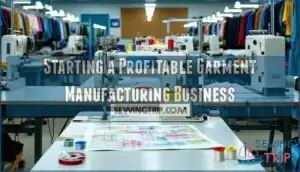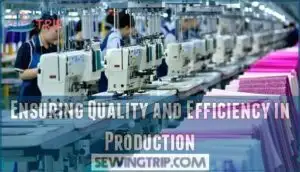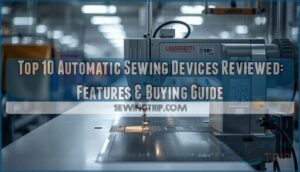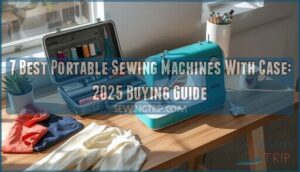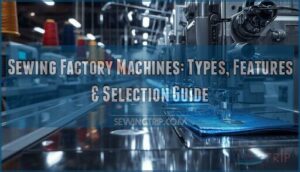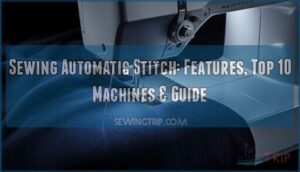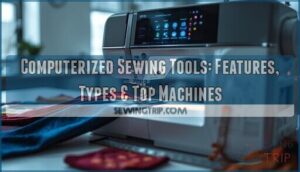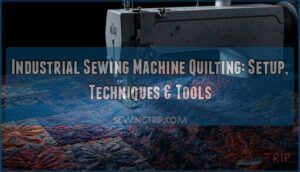This site is supported by our readers. We may earn a commission, at no cost to you, if you purchase through links.
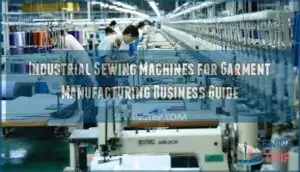
The difference between profitable operations and constant firefighting comes down to matching industrial-grade equipment to your specific production demands—whether you’re running custom orders from a spare bedroom or managing a 50-operator factory floor.
Table Of Contents
- Key Takeaways
- Industrial Sewing Machines: Types and Functions
- Garment Manufacturing Process Overview
- Choosing The Right Sewing Machine for Business
- Industrial Sewing Machine Market Trends
- Workforce Management in Garment Factories
- Investment and Cost Optimization Strategies
- Starting a Profitable Garment Manufacturing Business
- Ensuring Quality and Efficiency in Production
- Frequently Asked Questions (FAQs)
- Conclusion
Key Takeaways
- Your machine choices directly determine whether you run a profitable operation or spend years fighting costly downtime—matching lockstitch precision to woven fabrics, overlock systems to knit edges, and coverstitch capabilities to stretch materials separates efficient production from constant equipment failures.
- The industrial sewing machine market’s projected growth from $6.9 billion (2024) to $11.2 billion (2035) signals strong demand, but success depends on leveraging AI-driven predictive maintenance, IoT automation, and smart factory integration to cut changeover times and boost ROI while navigating persistent labor shortages.
- Quality control isn’t optional—implementing the 7-point defect grading system alongside systematic checkpoints at every production stage (cutting, assembly, finishing) protects your reputation and prevents costly shipment rejections before garments leave your facility.
- Starting profitable requires choosing between home-based operations ($2,000-$10,000 startup, 50-200 units monthly) and factory setups ($50,000-$500,000+, 5,000-50,000+ units monthly), then aligning your niche with documented market trends like sustainability segments growing 29% annually through rigorous competitive research and consumer insights.
Industrial Sewing Machines: Types and Functions
Your production floor runs on more than just fabric and thread—it needs the right machinery to turn raw materials into market-ready garments efficiently. Each machine type fulfills a distinct function in the manufacturing pipeline, and understanding these differences is critical for operational success.
Let’s examine the three core categories and specialized equipment that form the backbone of modern garment production.
Lockstitch Vs. Overlock Vs. Coverstitch
Your choice between lockstitch, overlock, and coverstitch machines isn’t just about picking equipment—it’s about matching the right tool to each seam’s purpose and the finished look you’re chasing. Here’s what separates these industrial sewing equipment workhorses:
- Industrial lockstitch machines deliver exceptional stitch quality for straight seams, with precise thread tension control enabling sewing speeds up to 5,000 stitches per minute across diverse fabric compatibility ranges.
- Industrial overlock systems finish edges while preventing fraying, essential for garment sewing where clean seam allowances define professional craftsmanship.
- Coverstitch machines create durable hems and decorative topstitching, particularly valuable for knit fabric applications requiring stretch retention.
- Machine durability directly impacts your production uptime—invest in equipment engineered for continuous industrial operation, not occasional use.
Blindstitch and Specialty Machines
While lockstitch, overlock, and coverstitch machines manage the visible construction work, blindstitch and specialty machines tackle the invisible details that separate amateur-grade garments from pieces customers won’t return. Blindstitch machines excel at blind hemming on trousers and skirts, delivering invisible stitches that maintain stitch quality without compromising fabric management precision.
| Machine Type | Primary Application | Production Impact |
|---|---|---|
| Blindstitch Machines | Invisible hems on formal wear | Professional finish quality |
| Button Attachers | High-volume fastening | 800+ buttons/hour output |
| Bartack Machines | Stress-point reinforcement | Reduced return rates |
Your garment manufacturing technology stack isn’t complete without these industrial sewing solutions. Machine maintenance schedules protect your investment, while sewing automation capabilities scale your output without sacrificing the invisible craftsmanship that defines your brand’s reputation in industrial sewing equipment markets.
High-Speed and Automation Features
High-speed machines stitching thousands of cycles per minute don’t just accelerate production—they rewrite the economics of your entire operation when paired with automation features that eliminate bottlenecks human operators can’t match.
Smart Factory integration connects industrial sewing machines to Automation Systems that monitor high-speed stitching performance in real-time, while Industrial Robotics manages automated cutting and fabric positioning. This sewing technology transforms garment manufacturing from labor-intensive craftsmanship into expandable precision:
- Production multiplies while defect rates plummet through consistent automated execution
- Labor costs compress as machines manage repetitive sequences human hands fatigue performing
- Delivery timelines shrink when weaving automation into every production stage
Garment Manufacturing Process Overview
Running a garment factory means understanding how raw materials become finished products. You’ll need to manage multiple production stages, each with its own demands and quality benchmarks.
Here’s what shapes your manufacturing workflow—from fabric arrival to final inspection.
Key Production Stages
Every garment that leaves your factory floor follows a carefully orchestrated journey from raw material to finished product. Understanding each production stage is crucial, as it separates profitable operations from costly inefficiencies. Your manufacturing workflow breaks down into distinct phases, each demanding precision.
| Stage | Core Activities |
|---|---|
| Production Planning | Pattern design, material calculation, timeline scheduling |
| Fabric Cutting | Marker making, spreading, cutting with precision tools |
| Sewing Techniques | Assembly using industrial sewing machine operations |
| Quality Inspection | Stitch verification, measurement checks, defect identification |
Each stage in your textile production builds on the previous one, creating a production line where efficiency compounds.
Fabric Selection and Preparation
Your choice of fabric dictates the garment’s final appearance, the machines you’ll need, and how much time you’ll spend correcting mistakes. Proper fabric selection and preparation prevent production delays and equipment damage.
- Material Sourcing: Evaluate fabric types for your garment manufacturing niche through textile production suppliers
- Fabric Testing: Verify shrinkage rates, colorfastness, and structural integrity before bulk orders
- Yarn Selection: Match fiber composition to sewing technology capabilities and end-use requirements
- Textile Finishing: Pre-wash, iron, and stabilize materials to guarantee dimensional accuracy
Quality Control in Apparel Manufacturing
Defects don’t announce themselves—they accumulate quietly until a shipment gets rejected, a client walks away, or your reputation takes a hit you can’t afford.
Quality Control in apparel production starts with Fabric Inspection and Material Testing before garments reach sewing lines.
You’ll catch Sewing Defects through systematic Quality Audits at each production stage—cutting, assembly, finishing—while Garment Sorting separates acceptable from rejected pieces.
Regular Sewing Machine Maintenance prevents mechanical errors that compromise textile industry solutions and overall manufacturing standards.
Choosing The Right Sewing Machine for Business
Selecting the right industrial sewing machine isn’t about finding the most expensive model—it’s about matching equipment capabilities to your production goals. Your choice will directly impact output speed, product quality, and long-term profitability.
The following factors will help you identify machines that align with your garment niche and operational requirements.
Factors to Consider (Speed, Durability, Cost)
When you’re investing thousands of dollars into equipment that’ll run eight hours a day, five days a week for the next decade, three factors will make or break your return on investment: speed, durability, and upfront cost.
Here’s how each factor impacts your operational budget and production volume:
- Sewing speed determines production costs—high-speed automation machines stitch thousands of stitches per minute, maximizing output.
- Equipment durability protects against costly downtime and frequent repairs that derail schedules.
- Initial price versus long-term machine efficiency—cheaper models often sacrifice reliability and performance.
Matching Machine Type to Garment Niche
Not all fabrics behave the same way, and pairing the wrong machine with your product line is like trying to cut silk with a butter knife—you’ll get nowhere fast. Machine selection hinges on fabric compatibility and garment specialization.
Lockstitch machines excel with woven fabrics in shirt production, while overlock machines manage knit fabrics in activewear. Coverstitch technology suits stretchy materials requiring professional hems.
Match your sewing techniques to your production optimization goals—fabric types dictate sewing machine selection in successful garment manufacturing operations.
Leading Brands and Models Compared
Juki, Brother, and Singer dominate the industrial sewing machine landscape, but understanding which model delivers the best ROI for your specific garment niche separates profitable operations from struggling startups.
Juki DDL-8700 leads in lockstitch technology for woven garments, while Brother S-7300A excels in pattern work. Market analysis shows Singer delivers budget-friendly entry points without sacrificing durability.
Compare model features against your apparel production machinery requirements—sewing technology advances faster than most factories upgrade equipment.
Industrial Sewing Machine Market Trends
The industrial sewing machine market is expanding rapidly, driven by global demand and regional manufacturing powerhouses. Understanding current trends helps you make strategic decisions about equipment investment and business positioning.
Let’s examine the growth patterns, innovations, and challenges shaping this industry today.
Global Growth and Regional Leaders
The industrial sewing machine market reached $6.9 billion in 2024, with projections hitting $11.2 billion by 2035—a 4.5% CAGR that signals strong global expansion. This growth is driven by increasing demand for industrial sewing machines.
Asia-Pacific dominates with 51.2% market share, driven by China’s manufacturing powerhouse producing 5.9 million units (63% of global output). India, the Philippines, and Bangladesh are key regional leaders in consumption, while North America shows the highest growth trajectory.
This economic impact reshapes textile production, influencing workforce management strategies and sewing technology adoption across garment manufacturing operations worldwide.
Technological Innovations Shaping The Industry
AI integration is transforming your shop floor. By 2025, AI-driven industrial sewing machines predict maintenance failures before they happen, cutting downtime and boosting ROI. Pattern recognition algorithms execute complex designs with precision, while machine learning adjusts stitching parameters in real time—maintaining uniformity across large runs.
Smart factories leverage IoT sewing technology: machines identify fabrics, adjust settings automatically, and send fault diagnostics to your dashboard. Digital threads and automated cutting systems reduce changeover times from hours to minutes, making micro-production economically viable in textile production and manufacturing innovation.
The growth of the industrial sewing machines market is driven by increasing demand for fashion trends and technological advancements.
Key Challenges: Labor, Costs, and Supply Chain
Even with smart factories running at peak efficiency, you still face the same grind: finding skilled operators, controlling costs, and keeping your supply chain from unraveling.
Global labor shortages persist—staffing levels drop as experienced personnel retire, forcing you into costly workforce planning and personnel management decisions.
Cost optimization hinges on inventory control and logistics planning, where supply chain management glitches can erase profit margins overnight.
Workforce Management in Garment Factories
Running a garment factory isn’t just about machines—it’s about the people who operate them. Your workforce strategy determines whether production flows smoothly or stalls under pressure.
Let’s break down the three critical elements that separate well-managed factories from chaotic ones.
Industrial Vs. Non-Industrial Employee Roles
Your garment factory runs on two distinct workforce categories—industrial employees who operate machinery and manage production tasks, and non-industrial staff who manage administration, supervision, and technical support. This employee classification defines your workforce analysis and labor distribution strategy.
Industrials include machine operators, cutters, and finishers, while nonindustrials manage quality control, scheduling, and technical oversight. Understanding this job segregation allows you to enhance labor relations and align skills with production demands effectively.
Staffing Levels and Retirement Planning
Managing headcount means forecasting who leaves, who stays, and how many hands you need on deck to meet production targets without burning cash on idle labor. You’ll track retirement patterns—say, 770 non-industrials exiting this year, 730 next—to plan succession and control labor costs.
Smart workforce planning balances employee benefits, job security, and retirement funds while maintaining staffing levels that protect both labour relations and your bottom line.
Training and Skill Development
Skilled operators don’t walk through your door ready-made—you build them through deliberate training programs that turn raw recruits into precision stitchers capable of hitting quality benchmarks shift after shift.
Invest in Vocational Training with certified instructors leading technical class sessions that cover Operator Certification, Skill Assessment, and Industrial Coaching.
Strong Apprentice Development improves workforce competence and strengthens labour relations, giving your team the edge to manage complex garments without costly rework.
Investment and Cost Optimization Strategies
Running a profitable garment business means keeping a tight grip on your finances. You can’t afford to guess where money goes or hope equipment pays for itself.
Let’s break down three cost areas that separate thriving factories from struggling ones.
Salary Scales and Pay Bill Analysis
Labor costs aren’t just line items on a spreadsheet—they’re the pulse of your factory’s financial health, and understanding them down to the penny can mean the difference between profit and loss. Your annual pay bill reflects workforce distribution: non-industrial roles managing administration versus industrial employees driving production.
Effective payroll management demands analyzing wage structures, projecting salary scales through retirement cycles, and evaluating benefit analysis during negotiations. Labour saving technologies reduce long-term employee compensation burdens while maintaining output quality.
Production Cost Reduction Tactics
Cutting waste from your production line isn’t about slashing quality—it’s about sharpening every process until inefficiency has nowhere to hide. Cost analysis reveals bottlenecks in your manufacturing process, while supply chain audits expose material waste.
Labor optimization through labour saving automation on your industrial sewing machine boosts production efficiency.
Track efficiency metrics weekly—waste reduction of even 5% compounds into substantial savings. Production cost optimization demands relentless attention to every stitch, every minute, every dollar.
Inventory Management and Digital Tracking
Real-time visibility into your fabric rolls, thread spools, and finished garments transforms chaotic stockrooms into profit centers—digital tracking systems have documented savings of $15,000 per large order by eliminating guesswork and overstock. Inventory control integrates with your production line, synchronizing supply chain and logistics data across every industrial sewing machine station.
Order management software prevents material shortages that halt operations, while logistics optimization ensures raw materials arrive precisely when needed—supply chain precision directly impacts your bottom line.
- Watch duplicate orders vanish as inventory management prevents costly reorders
- Experience the confidence of knowing exactly what’s on your production line at any moment
- Eliminate the panic of discovering fabric shortages mid-production through predictive logistics management
Starting a Profitable Garment Manufacturing Business
Launching a garment manufacturing operation requires strategic decisions that will shape your business trajectory from day one. You’ll need to evaluate your production model, identify your target market, and establish the legal and financial framework to support growth.
The following sections break down these critical choices so you can build a solid foundation for profitability.
Business Model Selection (Home-Based Vs. Factory)
Deciding where to set up shop—whether in your spare room or a dedicated factory floor—shapes everything from your startup costs to your production ceiling. Home-based operations minimize overhead and allow you to test your clothing manufacturing concept with minimal risk, while factory setups prepare you for rapid expansion with industrial sewing machines and dedicated production lines.
| Factor | Home Office | Garment Factory |
|---|---|---|
| Initial Investment | $2,000–$10,000 | $50,000–$500,000+ |
| Production Capacity | 50–200 units/month | 5,000–50,000+ units/month |
| Cost Analysis | Low overhead, limited growth | Higher fixed costs, expandable output |
Your business planning should align manufacturing and production capabilities with market demands and available capital.
Niche Identification and Market Research
Finding your ideal position in the $1.8 trillion global apparel market starts with thorough competitive research and consumer insights. Market trends reveal that sustainability-focused segments grew 29% annually through 2024, while functional apparel like athleisure expanded 14% yearly—both outpacing traditional categories.
Your niche analysis should examine target audiences through digital tools: 90% of major fashion brands now use ERP platforms for market analytics, cutting development cycles by 21 days.
Successful fashion business management pairs industrial sewing machine capabilities with documented consumer preferences—64% of buyers research brands on social media before purchasing, making your textile industry overview essential for business planning and finance decisions in garment manufacturing.
Legal, Financial, and Equipment Setup
Once you’ve identified your market position and validated consumer demand, you’ll need to structure the operational backbone that transforms research into revenue—starting with proper licensing, capital allocation, and machinery procurement.
Legal compliance requires business registration, zoning permits, and workplace safety certifications.
Financial planning should account for equipment costs—industrial sewing machines range from $800 to $15,000—alongside tax incentives for manufacturing investments.
Secure extensive insurance options covering production liability and property protection before implementing quality control protocols.
Ensuring Quality and Efficiency in Production
Running a profitable garment factory means nothing if your products don’t meet standards or your production line stalls. Quality and efficiency aren’t separate goals—they’re two sides of the same coin that determine whether you stay competitive.
Let’s look at three core practices that keep your operation sharp and your output consistent.
7. Point System in Garment Industry
The 7-point system acts as the industry’s definitive quality grading standard, assigning penalty scores to defects based on their severity and impact on garment appearance. Your Quality Metrics directly influence customer satisfaction and brand reputation in Textile Production.
- Critical defects (4 points) appear on visible areas and make garments unsaleable in your Garment Factory
- Major flaws (3 points) compromise functionality but don’t render items completely unwearable
- Minor imperfections (1 point) have minimal impact on overall garment quality
- Production Planning teams use accumulated scores to approve or reject batches
- Industrial Sewing Machine operators reference this standard to maintain consistent output across Supply Chain stages
Maintenance and Upkeep of Sewing Equipment
Proper maintenance schedules prevent expensive breakdowns and keep your machines running at peak performance long after quality inspections approve each batch. Daily Machine Lubrication and Thread Quality Control eliminate friction-related damage to Industrial Sewing Machine components.
You’ll reduce Maintenance Costs markedly through weekly Equipment Calibration checks and Sewing Needle Care protocols.
Heavy-Duty Materials demand consistent attention—Fabric Management Tips combined with Sewing Technology Advances help you extend equipment lifespan when Choosing the Right Sewing Machine for your production volume.
Quality Assurance Best Practices
Beyond keeping machines in working order, you need systematic checks at every production stage to catch defects before garments leave your facility.
Quality Control checkpoints on your Production Line—from Material Testing through Defect Analysis—protect your Supply Chain reputation.
You’ll meet Compliance Standards consistently when Quality Assurance protocols integrate with Industrial Sewing Machine operations, ensuring Garment Manufacturing output passes inspection before shipment.
Frequently Asked Questions (FAQs)
Is sewing business profitable?
Profit margins in the sewing business vary widely, but smart entrepreneurs can achieve solid financial returns.
Market demand drives success—specialized niches often outperform general production.
Your business investment strategies, including quality control and choosing the right industrial sewing machine, directly impact profitability and long-term growth.
How to start a garment manufacturing company?
Starting a clothing business requires Business Planning and Market Analysis to identify your niche.
You’ll need Financial Projections for Production Setup, then secure industrial sewing machines and establish Supply Chain Management.
Master Garment Manufacturing Techniques and understand the Clothing Manufacturing Process to run your Garment Factory efficiently.
What is the 15000 sewing machine scheme?
You’re likely referring to government Machine Subsidy programs or Equipment Funding initiatives in regions like India, where Manufacturing Loans and Factory Grants support Garment Manufacturing startups.
These Sewing Incentives help entrepreneurs afford Industrial Sewing Machines for Textile Manufacturing operations.
What is the 7 point system in garment industry?
While garment factories chase speed, Garment Inspection through the 7-point system flips priorities—assigning severity scores to defects based on visibility and impact.
Quality Control uses this structured approach to maintain Manufacturing Standards, ensuring your Garment Production meets Fashion Industry benchmarks before shipment.
How do industrial warranties compare across brands?
Warranty Comparison across major industrial sewing machine brands reveals significant differences in brand reliability and service contracts. Most manufacturers offer one to three years coverage on machine durability, though repair costs and production downtime vary widely based on your garment production volume and quality control requirements.
What financing options exist for equipment purchases?
Equipment Loans and Lease Options provide flexible cash financing for your Industrial Sewing Machine purchases.
Government Grants and Crowdfunding Platforms offer alternative funding sources.
Match financing terms to your Business Needs and calculate Investment Return against Production and Manufacturing goals before committing to Machinery investments.
How to scale from startup to factory?
Stitching together success means you’ll need strategic planning. Start by securing Startup Funding, then gradually add Industrial Sewing Machines to build your Production Line.
Focus on Operational Efficiency as you shift from a home workshop to a Garment Factory, scaling Garment Production through phased Factory Expansion and simplified Textile Manufacturing processes.
What certifications are required for garment exports?
Certification Standards and Trade Compliance govern exports—you’ll need quality control certifications, customs clearance documents, and global accreditation proving your garment factory meets international textile manufacturing requirements.
Export Regulations vary by destination market.
How sustainable practices affect manufacturing costs?
Going green isn’t penny-wise and pound-foolish—Sustainable Materials and Eco-Friendly processes in Textile Manufacturing initially raise costs. However, Waste Reduction and Green Manufacturing deliver long-term Cost Savings.
Your Industrial Sewing Machine choices, improved Workforce and Training, and smarter Garment Production methods markedly reduce Environmental Impact while boosting profitability.
Conclusion
Your competitive edge isn’t found in skirting investment—it flows from precise alignment between industrial sewing machine garment manufacturing business capabilities and production realities.
Match lockstitch reliability to volume targets, overlock consistency to finish standards, and automation features to labor constraints. Equipment decisions compound daily: choose wisely now, and your machines become profit engines; choose poorly, and they’ll drain resources for years.
Calculate throughput needs, verify service networks, then commit to tools that scale with demand.
- https://www.linkedin.com/pulse/general-industrial-sewing-machine-market-outlook-87dyc
- https://www.grandviewresearch.com/industry-analysis/sewing-machine-market-report
- https://textile-network.com/en/Business/Maximizing-productivity
- https://www.bls.gov/opub/ted/2024/productivity-growth-in-23-of-24-manufacturing-and-mining-industries-over-1987-2023.htm
- https://www.globalconsultantsreview.com/news/sewing-machine-day-2024-top-6-trends-in-sewing-technology-nwid-4746.html

